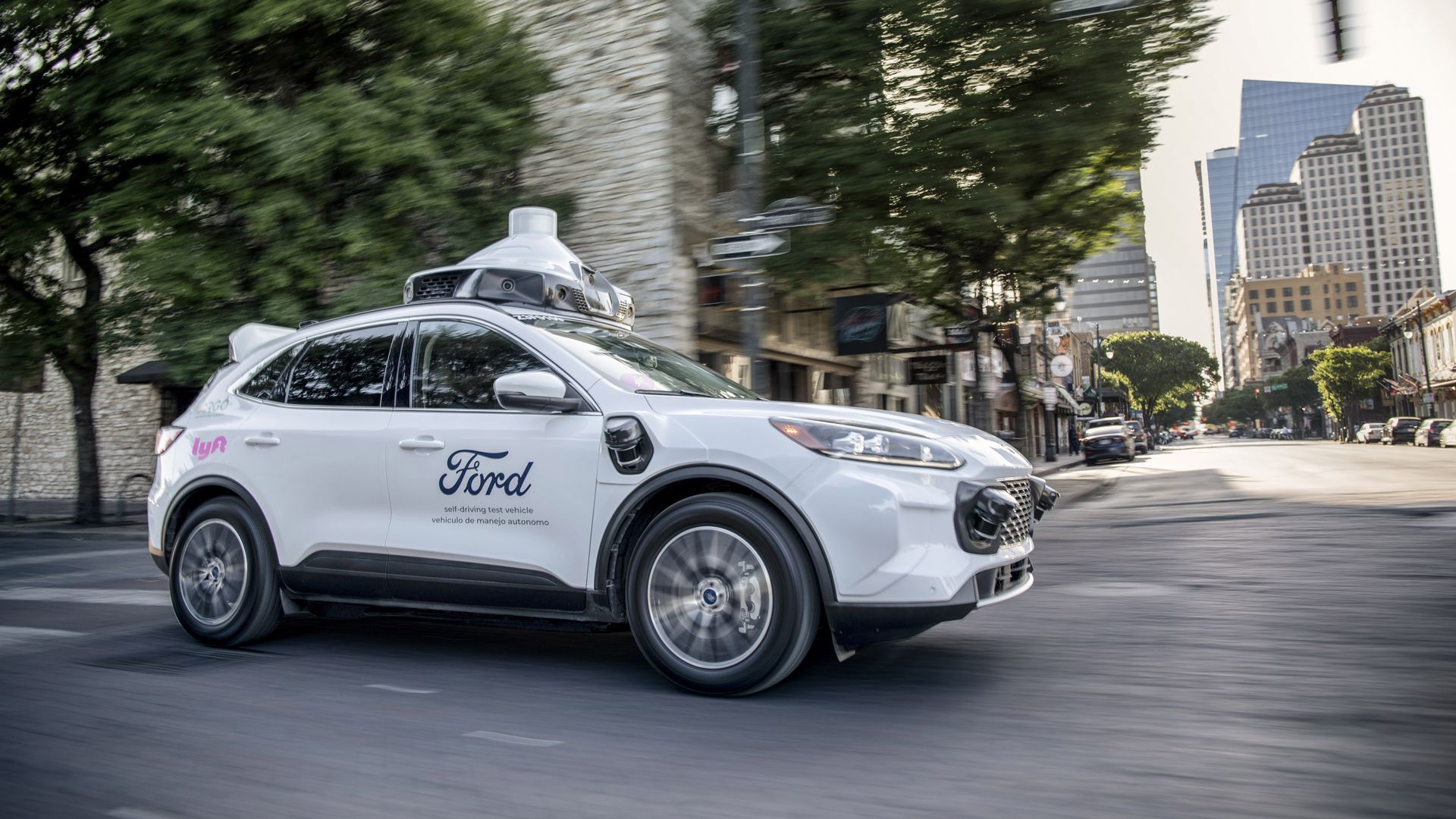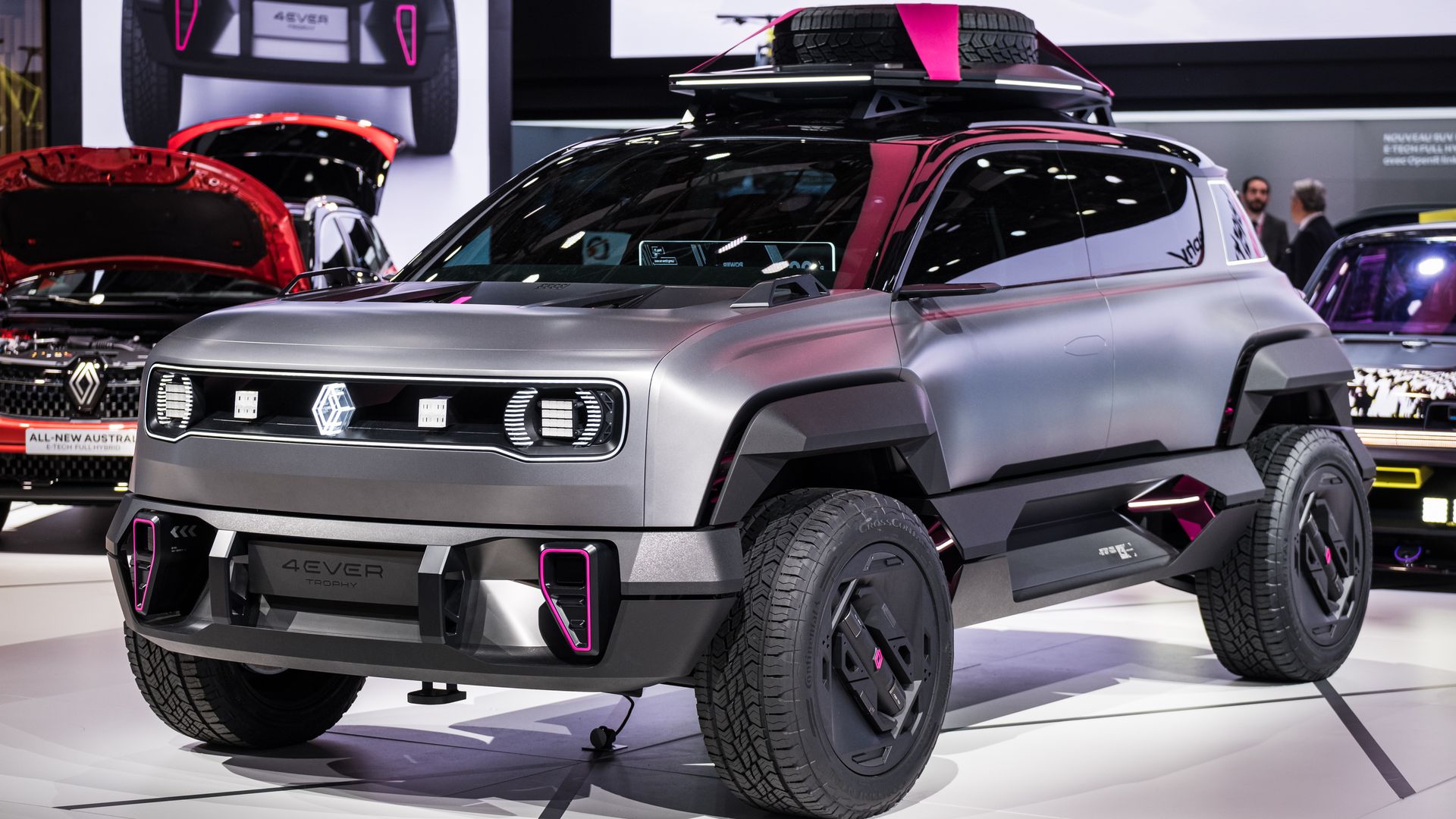| |
| |
| |
| Presented By Capital One |
| |
| Axios What's Next |
| By Joann Muller, Jennifer A. Kingson and Alex Fitzpatrick · Oct 19, 2022 |
| If you want to ride in an autonomous car, Uber or Lyft may be your best bet for a while, Joann reports today. - What world-changing stories should we be covering more often? Send your suggestions to whatsnext@axios.com.
- Join Axios' Joe Guillen and Joann Muller tomorrow at 12:30 p.m. ET for a virtual event exploring the next steps in the EV transition. Register here.
Today's newsletter is 1,012 words ... 4 minutes. |
| |
| |
| 1 big thing: Robotaxis roll out |
 |
|
| A Ford Escape outfitted with Argo AI autonomous technology available in the Lyft network. Photo courtesy of Lyft |
| |
| Lyft and Uber both gave up on developing their own self-driving cars, but the ride-hailing networks are still proving instrumental in rolling out driverless technology, Joann Muller reports. Why it matters: Both companies are starting to blend others' robotaxis into their ride-hailing fleets. - As autonomous cars pick up fares, they'll learn how best to drive alongside human motorists — insights that could help accelerate wider deployment.
Driving the news: Uber just announced a 10-year deal with Motional, a Hyundai-Aptiv joint venture, to deploy robotaxis in its network "in cities across the U.S., with the first trips expected to start later this year," the company says. - You can already hail a Motional robotaxi via Lyft in Las Vegas.
- Lyft also offers robotaxi service in Austin and Miami Beach in partnership with a different AV company, Argo AI.
- For now, these vehicles are operating with backup safety drivers. But they could be fully driverless within a year or two.
The big picture: Other AV developers — notably Waymo, Cruise and Zoox — are building proprietary robotaxi networks, which means their challenge is doubly hard. - Not only do they need to master self-driving technology, they also have to build the software to run a complex ride-sharing platform.
Where it stands: Waymo and Cruise are the farthest along in that journey. - Waymo has been offering a driverless taxi service called Waymo One in the Phoenix area since 2020. It's testing a similar service in San Francisco.
- Cruise's San Francisco robotaxi service is fully driverless during overnight hours (when traffic is lighter). It's planning to expand to Phoenix and Austin soon.
- Zoox, meanwhile, is seeking a permit to test-drive its robotaxi in California.
The catch: All these operations are limited to certain pre-mapped neighborhoods, under ideal conditions. - In other words, riders might not always be able to get where they want to go in a robotaxi.
That's where Lyft and Uber see an advantage over those AV startups. By feathering robotaxis into their already popular networks, they can ensure the customer always has a ride — whether it's autonomous or not. - In such a hybrid network, riders could be offered driverless cars when it makes sense and a traditional vehicle for other trips.
What they're saying: Lyft co-founder and president John Zimmer uses the analogy of a wireless carrier providing phone service. - "Imagine joining a network like Verizon, where you could make a call 1 out of 10 times," he told Axios in a recent interview. "And then imagine joining Lyft, where you can get a ride 10 out of 10 times, and one of those times might be in an autonomous vehicle."
- Akshay Jaising, Motional's vice president of commercialization, says it makes sense to partner with ride-sharing networks for now.
- "As a customer, you want to go to one app to get from point A to point B, and you want all the options you need to get there," he said in an interview with TechCrunch.
What to watch: Uber, which already uses Motional AVs for Uber Eats deliveries in California, has yet to say where its robotaxis will be available. Share this story. |
    |
| |
| |
| 2. We're buying fewer groceries |
 Data: U.S. Bureau of Labor Statistics; Chart: Erin Davis/Axios Visuals Americans are buying fewer items at the grocery store as food prices surge, per a new survey, Axios' Emily Peck reports. Why it matters: For a while, inflation was mainly changing what types of items consumers bought — more generics, different cuts of meat. - Now people are simply buying less, says Emily Moquin, food and beverage analyst at Morning Consult, which conducted the survey.
State of play: Nearly 25% of those surveyed by Morning Consult in September said they're buying fewer items at the grocery store in order to save money, up from 15% in October 2021. Of note: The cost of food eaten at home is up 13% from last year, according to the latest Consumer Price Index. Share this story. |
    |
| |
| |
| 3. Offshore wind goes west |
 |
|
| Illustration: Sarah Grillo/Axios |
| |
| Offshore wind energy is coming to the U.S. Pacific coast, Axios' Alan Neuhauser reports. Driving the news: The Interior Department will hold a wind energy lease auction in December for five areas off California's coast, officials announced Tuesday. Why it matters: The resulting developments are expected to generate at least 4.5 GW of electricity, according to American Clean Power. - That's roughly enough to power 1.5 million homes, the group says.
Of note: The waters off the Pacific coast are deeper than those in the Atlantic, so developers have to build wind turbines that float, instead of erecting them on platforms planted in the sea floor. What to watch: The Biden administration's goal is to develop 30 GW of offshore wind energy and 15 GW of floating offshore wind power. Read the rest. |
    |
| |
| |
| A message from Capital One |
| How car ownership changed his family's life |
| |
 |
| |
| Last year, Earnest Barnes struggled to find a job. His community lacked public transit, so his wife and four kids relied on costly delivery and rideshare options. On The Road Lending helped Barnes apply for a car loan for a reliable vehicle. This opened the door to trade school. Read the full story. |
| |
| |
| 4. 📸 Renault's rugged eSUV |
 |
|
| Photo: Richard Bord/Getty Images |
| |
| French automaker Renault used this week's Paris Motor Show to unveil its 4Ever Trophy concept vehicle — a rugged, electric mini-SUV. - The name is a throwback to the Renault 4, a popular compact the company sold for about 30 years before production ended in the early 1990s.
Concepts rarely make it to production — instead, they're a way for automakers to show off some of their most ambitious thinking. - But car blog Jalopnik reports the 4Ever Trophy is "95% of the way to production-spec," so maybe we'll actually see something like this cruising around Paris or Nice sometime soon.
💬 Alex's thought bubble: Why does Europe always get the coolest cars? Sigh. |
    |
| |
| |
| 5. One fun thing: Studio Ghibli, the park |
 |
|
| A display of the Cat Bus from the film "My Neighbor Totoro," by Studio Ghibli. Photo: Tomohiro Ohsumi/Getty Images |
| |
| Studio Ghibli fans will be able to step inside the worlds of "Spirited Away" and "My Neighbor Totoro" when Ghibli Park opens in Nagakute, Japan next month, Axios' Hope King reports. Details: The 494-acre "hybrid park" is an homage to 81-year-old Hayao Miyazaki, a world-renowned animator and creator who co-founded Ghibli in 1985. What they're saying: The park is "designed so that you feel like you are living in an actual Ghibli world rather than visiting a fantasy. The result: a sensory overload that is peaceful at the same time," per Washington Post reporters who visited. What's next: Three areas of the park will open next month in a phased approach that will limit the number of visitors to about 5,000 a day. Share this story. |
    |
| |
| |
| A message from Capital One |
| Democratizing car ownership |
| |
 |
| |
| Car ownership can open new doors, including improved employment opportunities. The problem: 84% of lower-middle income earners who don't own a car said they turned down a job due to not having a car. Capital One teamed up with On the Road Lending to democratize car ownership. See the impact. |
| |
| Big thanks to What's Next copy editor Amy Stern. Was this email forwarded to you? Get your daily dose of What's Next by signing up here for our free newsletter. |
 | | Are you a fan of this email format? It's called Smart Brevity®. Over 300 orgs use it — in a tool called Axios HQ — to drive productivity with clearer workplace communications. | | |









No comments:
Post a Comment